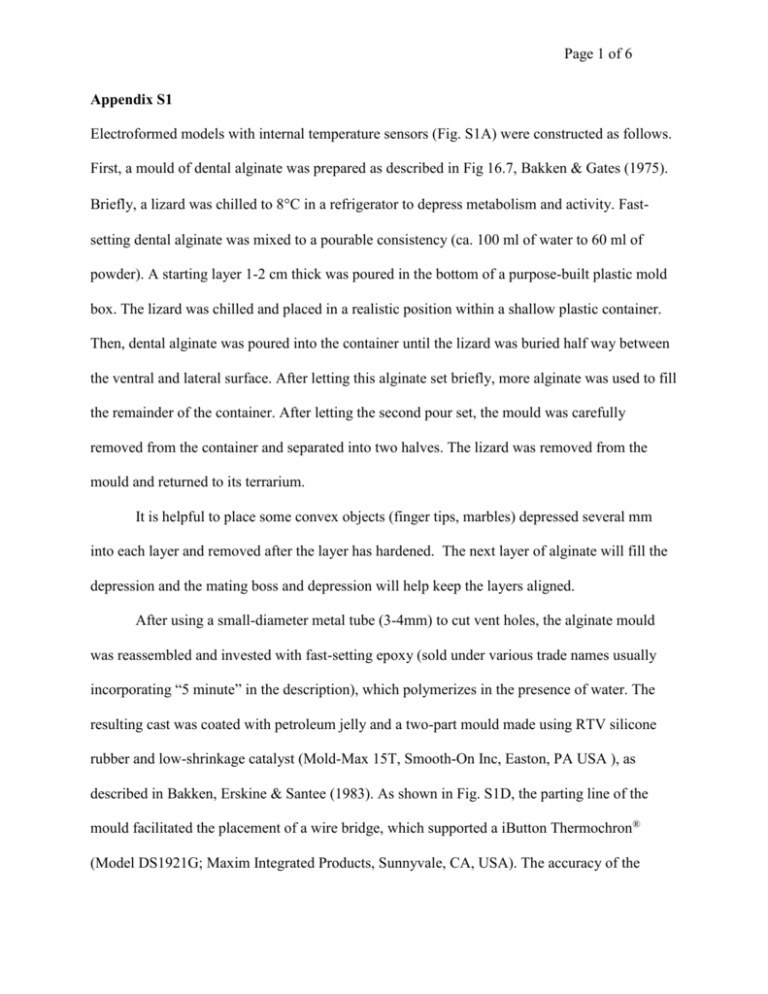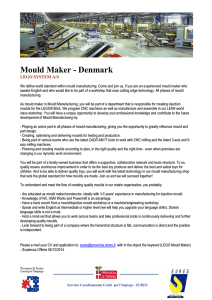fec12149-sup-0002-AppendixS1_FigS1-S2
advertisement

Page 1 of 6 Appendix S1 Electroformed models with internal temperature sensors (Fig. S1A) were constructed as follows. First, a mould of dental alginate was prepared as described in Fig 16.7, Bakken & Gates (1975). Briefly, a lizard was chilled to 8C in a refrigerator to depress metabolism and activity. Fastsetting dental alginate was mixed to a pourable consistency (ca. 100 ml of water to 60 ml of powder). A starting layer 1-2 cm thick was poured in the bottom of a purpose-built plastic mold box. The lizard was chilled and placed in a realistic position within a shallow plastic container. Then, dental alginate was poured into the container until the lizard was buried half way between the ventral and lateral surface. After letting this alginate set briefly, more alginate was used to fill the remainder of the container. After letting the second pour set, the mould was carefully removed from the container and separated into two halves. The lizard was removed from the mould and returned to its terrarium. It is helpful to place some convex objects (finger tips, marbles) depressed several mm into each layer and removed after the layer has hardened. The next layer of alginate will fill the depression and the mating boss and depression will help keep the layers aligned. After using a small-diameter metal tube (3-4mm) to cut vent holes, the alginate mould was reassembled and invested with fast-setting epoxy (sold under various trade names usually incorporating “5 minute” in the description), which polymerizes in the presence of water. The resulting cast was coated with petroleum jelly and a two-part mould made using RTV silicone rubber and low-shrinkage catalyst (Mold-Max 15T, Smooth-On Inc, Easton, PA USA ), as described in Bakken, Erskine & Santee (1983). As shown in Fig. S1D, the parting line of the mould facilitated the placement of a wire bridge, which supported a iButton Thermochron® (Model DS1921G; Maxim Integrated Products, Sunnyvale, CA, USA). The accuracy of the Page 2 of 6 Thermochron® can be improved by individual calibration (Angilletta & Krochmal 2003), and models with better resolution and more memory (DS1922L) are now available. Vent holes are cut in the rubber mould as for the alginate mould. The bridge was constructed by first covering the junction between the two metal parts of the Thermochron® with liquid vinyl (Liquid Electrical Tape, StarBrite Ft. Lauderdale, FL, USA). A stranded insulated wire (22 AWG) was fastened to the center of the Thermochron® with conductive epoxy (MG Chemicals, Burlington, Ont., Canada). Two solid wires (20 AWG) were fastened to each side of the case (Fig. S1B). The assembly was then fully sealed in liquid vinyl, except for the free ends of the wires, to prevent flakes of conductive paint from shorting the Thermochron®, and placed in the silicone mould (Fig. S1D). The mould was pre-heated and then invested (Fig. S1C) with a synthetic low-shrinkage wax (Ferris 2283-A; Freeman Mfg., Avon, OH, USA). Care was taken to keep the temperature of the Thermochron® below 70C; the upper operating temperature of a Thermochron® is 85C, and battery life is shortened at high temperatures. The solid wires protruding from the side of the cast were cut to 3-4mm length and bent along the side of the wax cast. The cast was then coated with conductive silver paint (e.g. CircuitWriter CW100L-4; Caig Laboratories, Poway, CA, USA), which was allowed to dry for 24 h. The copper wires of the bridge were scraped with a knife to expose bare copper to ensure electrical bond with the electroformed copper, wearing clean vinyl gloves and avoiding intentional contact with the silver print to avoid impairing the conductive paint. A layer of copper (ca. 1 mm) was electroformed on the wax cast using a copper sulfate solution with a brightening additive (e.g. Udylite UBAC R-1; Enthone Inc., West Haven, CT, USA). Openings were cut through the electroformed copper under the lower jaw, at the tip of each leg, and around Page 3 of 6 the data wire protruding from the tail. The model was then placed in a water bath at 70°C to remove the wax. To minimize exposure to high temperatures, the removal of wax was expedited by pumping hot water through a plastic tube forced over the tail. The resulting electroform was cleaned by soaking in paint thinner to remove residual wax. After cleaning, the exterior of the model was painted to match the absorptive properties of the focal lizard. To communicate with the Thermochron®, an adapter with two alligator clips (Fig. S2) was made to fit in the iButton Blue Dot Receptor (Model DS1402D-DR8). The clip attached to the outer ring was connected to the electroformed shell, while the clip attached to the center button was connected to the wire coming out of the model’s tail. REFERENCES Angilletta, M.J. & Krochmal, A.R. (2003) The thermochron: A truly miniature and inexpensive temperature logger. Herpetological Review, 34, 31-32. Bakken, G.S., Erskine, D.J. & Santee, W.R. (1983) Construction and operation of heated taxidermic mounts used to measure standard operative temperature. Ecology, 64, 16581662. Bakken, G.S. & Gates, D.M. (1975) Heat-transfer analysis of animals: some implications for field ecology, physiology, and evolution. Perspectives of Biophysical Ecology (eds D.M. Gates & R.B. Schmerl), pp. 255-290. Springer-Verlag, New York. Page 4 of 6 Supplemental Figure Captions Fig. S1. Photo showing steps in the construction of an anatomically accurate Te thermometer with an internal temperature logger. A) Completed assembly. B) Exploded view showing the internal structure and wiring before the final vinyl coating. C) Wax cast with a Thermochron® in lower half of silicone mould. D. Upper half of silicone mould with fully coated Thermochron® in position. Fig. S2. A schematic of a custom adapter for an iButton Blue Dot Receptor. The adaptor provides connections for downloading data from electroformed Te thermometers with an internal Thermochron®. Page 5 of 6 A Fig. S1 B C D Page 6 of 6 Teflon 6 mm brass machine screw Aluminum 15 mm 7 mm 16.25 mm Fig. S2









